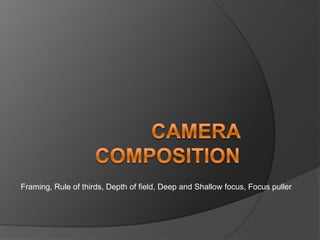Camera composition
- 1. Framing, Rule of thirds, Depth of field, Deep and Shallow focus, Focus puller
- 2. Framing (position of the subject) ï When framing people, you should generally put their eye-level about two thirds of the way up the screen.
- 3. ï In shots, leave a little headroom â space between the top of the head and the edge of the TV screen.
- 4. ï If the person youâre shooting is looking off-screen (not directly into the camera) make sure you leave some ânose-roomâ, or âtalking spaceâ.
- 5. Rule of Thirds ï Horizontal lines, like the horizon, can look boring if you place them in the centre of the screen. They look much better one third from the top or bottom. The same applies for vertical lines â put vertical objects one third in from the left or right of the screen. If you divide your screen into thirds, both vertically and horizontally, the four intersecting points are âpoints of interestâ where the eye is naturally drawn. Consider these âsweet-spotsâ when framing up.
- 8. Depth of Field ï Depth of field is the front-to-back range of focus in an image â that is, how much of it appears sharp and clear. ï It is the distance between the nearest and farthest objects in a scene that appear acceptably sharp in an image. ï Lens can alter the sharpness levels. ï The focal length of the camera lens can alter the depth of changes.
- 10. Deep and Shallow Focus ï Deep focus uses a large depth of field. Consequently, in deep focus the foreground, middle-ground and background are all in focus.
- 11. ï Shallow focus uses a small depth of field. ï In shallow focus one plane of the image is in focus while the rest is out of focus.
- 12. Focus Pulls (Movement) ï Focus pulls are frequently used to shift the focal point from one part of a scene to another. For example, an actor may be in focus at a distance of 20ft from the camera at the far side of the room and the shot includes a telephone in the foreground which is out of focus. As the phone rings, the actor turns and the focus puller pulls focus so that the phone becomes sharp and the actor goes out of focus. This action is a focus pull.
- 14. Guess!
- 19. Wrong or Right?
























